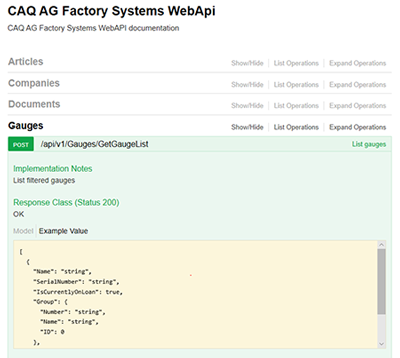OpenAPI and the Industrial Internet of Things
The API in CAQ.Net facilitates real-time communication with virtually any third-party application. It allows you to integrate our software into any element of your IT-system landscape and to depict almost any CAQ.Net function within your MES, ERP, or individual app – thus paving the way for an Industrial Internet of Things (IIoT).
A worker in the production facility approaches a brand-new machine. He looks at it and wants to spontaneously try it out. Why not? After all, one surely must be allowed to give it a go. As always, he first has to identify himself at the machine and the connected MES for authorization purposes. He then gets ready to fire up the machine. But then ... silence. The machine doesn’t make a sound.
Is He Allowed to Do That?
Well, actually, the machine does in fact make a sound, because it tells him that he does not have the necessary qualifications to operate it. He should please first complete the necessary training and instruction – for his own protection, for the protection of the machine itself, and for the protection of the not insignificant investment that the machine represents for the company. The machine shows him directly on the display which training courses are required. What exactly happened here?
 CAQ AG Factory Systems WebApi
CAQ AG Factory Systems WebApi
When Two IT-Systems Meet ...
The machine is connected to the MES, but qualifications are maintained in the Training Management Software Qualify.Net. What happened is that the two systems exchanged information in real time. The MES asked CAQ.Net via OpenAPI whether the identified employee was allowed to operate the machine and the CAQ module checked whether he had already received the necessary instructions in their most current version. Shopfloor had briefly double-checked things with the management system.
Application Programming Interface
This interaction between two IT-systems that are isolated and in parts fundamentally different is made possible by a so-called Application Programming Interface (API). This is a program part that is made available by a software system to other programs for connection purposes. In addition to access to databases or hardware, a programming interface can also enable or simplify the creation of components of the graphical user interface. An API thus enables communication between different systems in real-time.
A Long Way
In the early stages of todays digitalization, IT-systems such as ERP, CAQ, or MES existed as separate, in fact even isolated entities within a company. There was no integration of systems and information had to be brought together independently. This changed with data integration by means of interface modules that link individual systems. Like CAQ AG’s Connect.Net, these interface modules made it possible to exchange data between different IT-systems on a time-triggered basis. Todays APIs virtually eliminate the factor of time, as they ensure real-time information exchange as well as complete data integration and visualization.
What is the OpenAPI in CAQ.Net?
The API in CAQ.Net facilitates the querying and changing of data in real-time. It corresponds to the OpenAPI (Swagger) specification and can therefore be directly addressed by a variety of third-party applications. Among many other possibilities, master data such as articles, customers, suppliers, etc. can be exchanged via this interface. Inspection orders can be queried/created and documents or, as in the introductory example, the qualification status of persons can be retrieved. There are no limits to CAQ.Nets real-time communication with third-party applications using OpenAPI: complaint data and supplier data can be exchanged between ERP and CAQ, PDA systems can be supplied with data, or MDA terminals can be connected directly.
Future-Proof
CAQ.Net offers a continuously growing, versioned catalogue of update-safe API standard functions, which is expanded with each release. The best thing about OpenAPI in CAQ.Net is, however, that necessary front-ends or browser apps can be developed completely independently thanks to an open documentation of the API.
The Industrial Internet of Things
The direct integration of data and functions from subsystems in real time and the use of update-proof machine/human readable API-calls drastically reduces the possibility of input errors and thus minimizes the risk of information loss. The resulting system transparency and the consistent use of real-time data are probably the most important building blocks on the way to the Industrial Internet of Things and the Smart Factory of tomorrow.
Additional Links